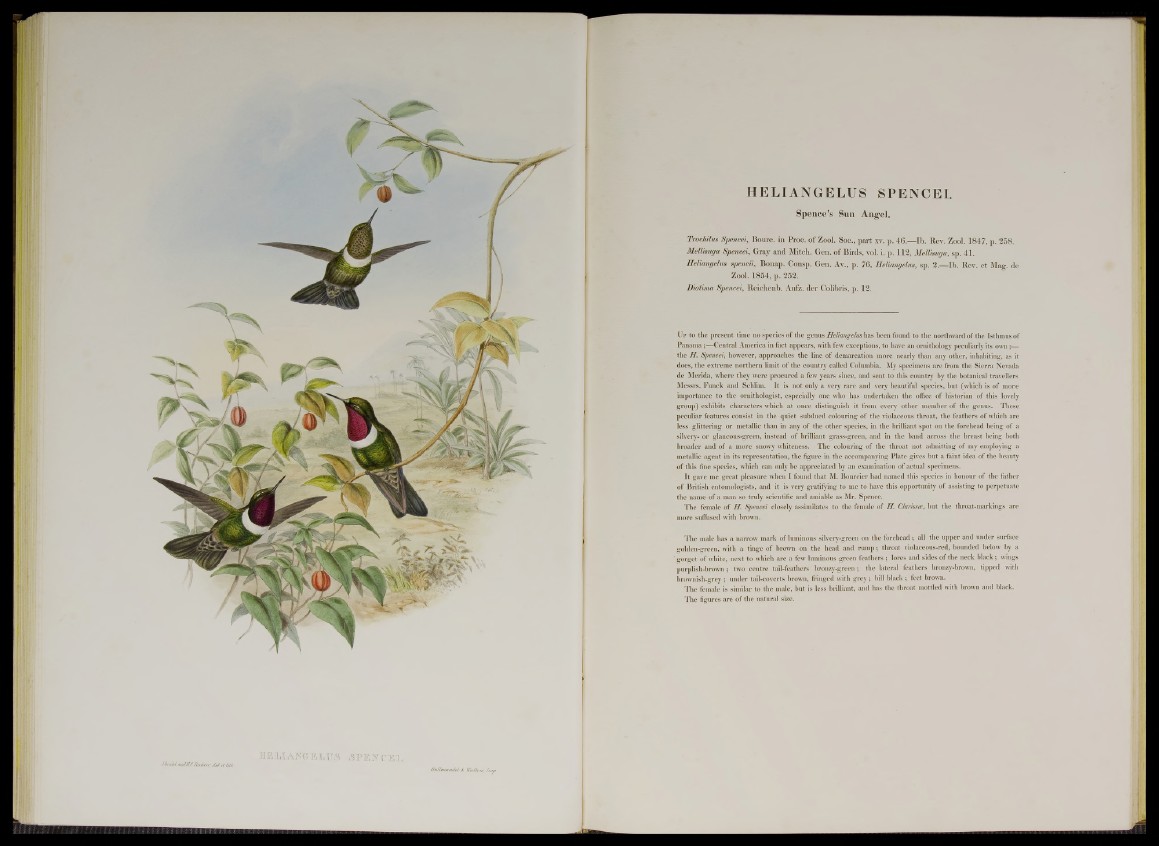
JO ciM touM C H úA /rr M e t
//u U rn a n d tl' A W ttOow. 7>n>
HELIANGELUS SPENCEI .
Spence’s Sun Angel.
Trochilm Spencei, Bourc. in Proc. o f Zool. Soc., p a rt xv. p. 46.— lb . Rev. Zool. 1847, p. 258.
Mellixuga Spencei, Gray an d Mitch. Gen. o f Birds, vol. i. p. 112, Mellimga, sp. 41.
Eelmngelus sp e rm , Bonap. Consp. Gen. Av., p. 76, Eeliangelm, sp. 2.— lb . Rev. e t Mag. de
Zool. 1854, p. 252.
JDiotima Spencei, Reichenb. Aufz. der Colibris, p. 12.
Up to the present time no species of the genus Heliangelus has been found to the northward of the Isthmus of
Panama;—Central America in fact appears, with few exceptions, to have an ornithology peculiarly its own y—
the H. Spencei, however, approaches the line of demarcation more nearly than any other, inhabiting, as it
does, the extreme northern limit of the country called Columbia. My specimens are from the Sierra Nevada
de Merida, where they were procured a few years since, and sent to this country by the botanical travellers
Messrs. Funck and Schlim. It is not only a very rare and very beautiful species, but (which is of more
importance to the ornithologist, especially one who has undertaken the office of historian of this lovely
group) exhibits characters which at once distinguish it from every other member of the genus. These
peculiar features consist in the quiet subdued colouring of the violaceous throat, the feathers of which are
less glittering or metallic than in any of the other species, in the brilliant spot on the forehead being of a
silvery- or glaucous-green, instead of brilliant grass-green, and in the band across the breast being both
broader and of a more snowy whiteness. The colouring of the throat not admitting of my employing a
metallic agent in its representation, the figure in the accompanying Plate gives but a faint idea of the beauty
of this fine species, which can only be appreciated by an examination of actual specimens.
It gave me great pleasure when I found that M. Bourcier had named this species in honour of the father
of British entomologists, and it is very gratifying to me to have this opportunity of assisting to perpetuate
the name of a man so truly scientific and amiable as Mr. Spence.
The female of H. Spencei closely assimilates to the female of H. Clarissa, but the throat-markings are
more suffused with brown.
The male has a narrow mark of luminous silvery-green on the forehead; all the upper and under surface
golden-green, with a tinge of brown on the head and rump; throat violaceous-red, bounded below by a
' gorget of white, neixt to which are a few luminous green feathers ; lores and sides of the neck black; wings
purplish-brown; two centre tail-feathers bronzy-green; the lateral feathers bronzy-brown, tipped with
brownish-grey ; under tail-coverts brown, fringed with grey ; bill black ; feet brown.
The female is similar to the male, but is less brilliant, and has the throat mottled with brown and black.
The figures are of the natural size.